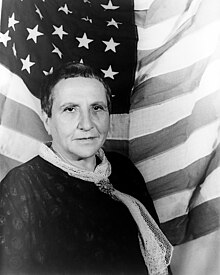
The sentence "Rose is a rose is a rose is a rose" was written by Gertrude Stein as part of the 1913 poem "Sacred Emily", which appeared in the 1922 book Geography and Plays. In that poem, the first "Rose" is the name of a person. Stein later used variations on the sentence in other writings, and the shortened form "A rose is a rose is a rose" is among her most famous quotations, often interpreted as meaning[1] "things are what they are", a statement of the law of identity, "A is A."
In Stein's view, the sentence expresses the fact that simply using the name of a thing already invokes the imagery and emotions associated with it, an idea also intensively discussed in the problem of universals debate where Peter Abelard and others used the rose as an example concept. As the quotation diffused through her own writing, and the culture at large, Stein once remarked, "Now listen! I'm no fool. I know that in daily life we don't go around saying 'is a ... is a ... is a ...' Yes, I'm no fool; but I think that in that line the rose is red for the first time in English poetry for a hundred years." (Four in America).[2]
She said to an audience at Oxford University that the statement referred to the fact that when the Romantics used the word "rose", it had a direct relationship to an actual rose. For later periods in literature this would no longer be true. The eras following Romanticism, notably the modern era, use the word rose to refer to the actual rose, yet they also imply, through the use of the word, the archetypical elements of the romantic era.
The following lines appear at widely separated places in "Sacred Emily":